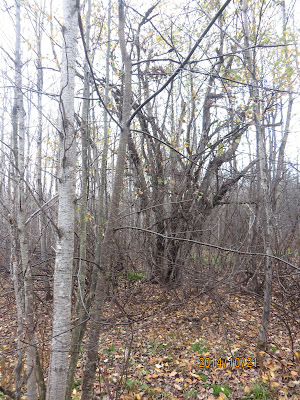We
live about as far north as the early farmers ever tried to work the earth, at
least in New England. Most left not long after they started and there never
were a lot of them, but occasionally an abandoned foundation or old stone wall
is stumbled upon.
In 1815, the volcano Mount Tambora exploded in the Dutch East
Indies and set off a global weather anomaly that caused the summer of 1816 to
be known as The Year Without a Summer. That June it snowed six inches in many
parts of northern New England and it didn’t melt for a week. The event convinced
many that farming this far north was impossible.
 |
| An apple tree gone wild. |
So
the abandoned farms are few and far between. We find them occasionally, usually
with a few apple trees nearby and maybe a stone wall or foundation. The bears
do a number on the apple trees sometimes, but those old trees are tenacious and
wild ones abound. Abandoned fields in the forest are called openings by the
locals, and every year the openings grow smaller and rarer. High bush
cranberries, poplars, and blueberries creep in, soon followed by spruce and fir
trees. Those left-behind openings can have some excellent grouse hunting around
the edges.
Up
here, the more common grouse habitat is logged over country that is rebounding.
Usually an area will provide good grouse hunting a few years after it is cut,
until the trees are twenty years old or so and starting to mature. Throw in a
few softwood trees for shelter and a stream, so the grouse can pick at washed
up gravel, and that cutting is going to hold grouse.
So
up here we study Google Earth and tramp all over the place looking for grouse
around these cuttings. I like to follow the edges, particularly if poplar and
maple are growing and softwoods are close by. For reasons that I have never
figured out, if choke cherry is the predominate specie coming up there seldom
are grouse. High bush cranberry, blueberries, raspberries, and mountain ash are
a bonus.
Imagine
my surprise when the edge of a clear cut led into a stand of wild apple trees,
some of them thirty feet tall, with spruce and fir trees, red twig dogwood, and
young maples mixed in. It certainly looked like an abandoned orchard. Some
areas even had patches of grass remaining. The nearest paved road was seven or
eight miles away, and the nearest gravel road half that.
 |
| My old girl Chara on a grouse. |
And
there were grouse, lots of them, and even a pair of woodcock.
A
wide circle through the apples brought me back to the edge of the clear cut
where stones shrouded in moss had been arranged to make a small foundation and
a rock wall hid beneath leaves and lichens. Kicking fallen leaves around produced
a rusty barrel hoop, but nothing more. Maybe someday I will go poke around
again.
 |
| All that remains of a homestead. |

No comments:
Post a Comment